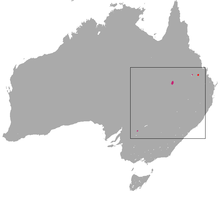Bridled nailtail wallaby
| Bridled nail-tail wallaby | |
|---|---|
 |
|
| Female bridled nail-tail wallaby (Onychogalea fraenata) with a joey in its pouch at David Fleay Wildlife Park, Burleigh Heads, Queensland | |
| Scientific classification | |
| Kingdom: | Animalia |
| Phylum: | Chordata |
| Class: | Mammalia |
| Order: | Diprotodontia |
| Family: | Macropodidae |
| Genus: | Onychogalea |
| Species: | O. fraenata |
| Binomial name | |
|
Onychogalea fraenata (Gould, 1841) |
|
 |
|
The bridled nail-tail wallaby (Onychogalea fraenata), also known as the bridled nail-tailed wallaby, bridled nailtail wallaby, bridled wallaby, merrin, and flashjack, is a vulnerable species of macropod. It is a small wallaby found in three isolated areas in Queensland, Australia, and whose population is declining. The total population of the species is currently estimated to be less than 1,100 mature individuals in the wild.
This small wallaby is named for two distinguishing characteristics: a white "bridle" line that runs down from the back of the neck around the shoulders, and the horny spur on the end of its tail. Other key physical features include a black stripe running down the dorsum of the neck between the scapulae, large eyes, and white stripes on the cheeks, which are often seen in other species of wallabies as well.
The bridled nail-tail wallaby can grow to one metre in length, half of which is tail, and weighs 4–8 kg. Females are somewhat smaller than the males. The tail spur can be 3–6 mm long and partly covered in hair. Its purpose is unclear.
The "nail-tail" is a feature common to two other species of wallabies: the northern nail-tail wallaby and the crescent nail-tail wallaby (which was declared to be extinct in 1956).
At the time of European settlement of Australia, bridled nail-tail wallabies were common all along the East Australian coastline region to the west of the Great Dividing Range. Naturalists in the 19th century reported that the species ranged from the Murray River region of Victoria through central New South Wales to Charters Towers in Queensland.
...
Wikipedia

